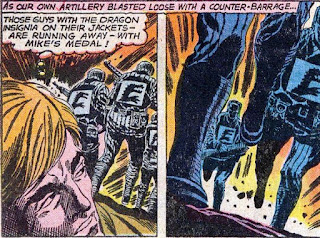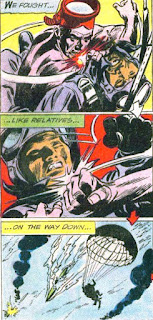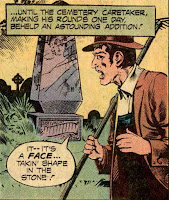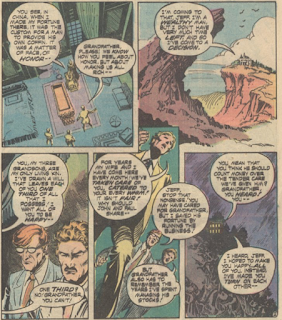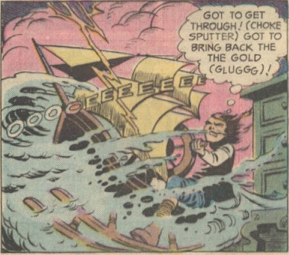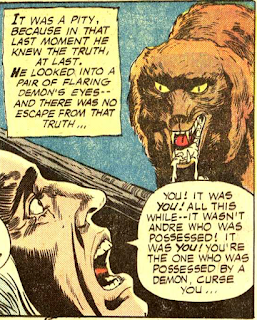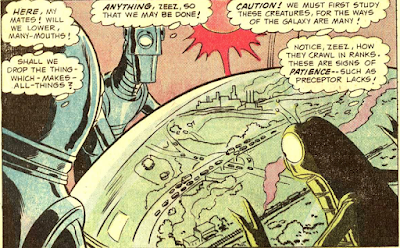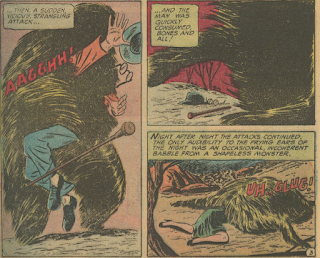Ajax-Farrell
Part Three
By Jose Cruz and
Peter Enfantino
Note: We rely on the fine people at Comic Book Plus and Digital Comic Museum for public domain digital downloads. Unfortunately, a full run of Haunted Thrills isn't available yet so we've had to resort to reading several stories via their reprints in the Eerie Publication titles, similarly available for download at this essential site. Though we'd obviously prefer to use the original comic books, we can't afford to purchase these very expensive issues. We thought this the best avenue rather than missing out on so many terror tales but, of course, it necessitates representing some artwork in black and white (including the featured reprints). We hope that you will agree with our decision and enjoy the stories in these altered formats. -Jose and Peter
 |
| The haunting finale |
What begins as perhaps just another murder/love triangle escalates into something disturbing and, ultimately, unforgettably tragic. Sadly, we don't know the true author or artist of "Hands of Terror" (from #5) so I can't heap praise upon them by name (or immediately seek out their other work) but I assume that they were employed by the ubiquitous "Iger Studios." The script (and art) do an abrupt left turn on page five (I find it hard to believe that the same artist is responsible for the splash [above] and that exquisitely creepy finale. Natalie is still alive as Vincent carries her into the fetid water and I can't imagine her drowning death was very pleasant but then I guess that was the woman's wish in the end anyway, wasn't it? The scene is reminiscent of the equally downbeat climax of the Universal film, The Mummy's Ghost (1944). Our unnamed writer adds the unsettling "And so they slept..." as the epitaph to a powerful tale that will remain with me for quite some time.
Jose: Aging officer Tim Brian--the guy so nice they named him twice--is out walking his beat in a quiet neighborhood one evening when he discovers something decidedly more exciting than his usual unruly street cats: a corpse! Brian calls the body in and marvels over the coroner’s findings that the corpse was drained of all its blood but otherwise physically unharmed. When the chief asks Brian his opinion on the matter, the old codger is quick to place the blame on a weird patch of land in the neighborhood that the cats always stray from. And it’s a known fact that cats know when a spot is haunted! Word quickly gets around the precinct of Brian's theories and it isn’t long before he is laughed right out of the job. Dejected, Brian makes his usual rounds only to be accosted by a strange man who then vanishes in a horrific fog. Running to the cursed property, Brian is amazed to see a mansion now sitting cozily in its place. A friendly ghoul greets the policeman at the door and bids him enter, where a hypnotic vampire lady tries to put the bite on him. The tough cop’s attempt to arrest the mistress backfires when she zaps the mansion back into the ether, but upon some brief reflection Brian recalls the bit of folklore shared by his mother that tells of the one sure-fire way to clear out evil spirits: sweeping them off with a broom! Thus armed, Brian goes back to the property and triumphantly bristles the monsters straight to hell. The strain is too much for the officer though and he himself passes away amidst the bones of the creatures, a memorial later created in honor of his heroic efforts.
| Sweep for your life! |
Even with its unconventional finish for the monsters, “Nightmare Mansion” (from #3) manages to be a bittersweet drama with a concentrated focus on character sorely lacking from many of the pre-codes. Brian’s humiliation at facing the derision of his peers is especially poignant and handled with grace, the impotence he feels as an aging policeman forced to work a dull beat made immediately potent in the opening panels. Brian has our sympathy from the word “Go” and the rest of the tale succeeds in keeping interest high with its constantly morphing threats. We think they’re vampires at first, but that’s only part of it. They're also ghouls too. And they travel dimensions. And cats hate them! It’s a credit to our anonymous writer that they manage to keep the delivery of all these elements effortless without the story ever appearing too stuffed on its concepts. You gotta love that sweet, wholesome artwork too; it’s reminiscent of DC’s early Silver-Age Flash stories.
Peter: Heartless skipper Jeff Bolden runs a tight ship and when he discovers that cholera has broken out onboard while the ship is at sea, he naturally clams up even though the men are dropping like flies. Worse though, is the sudden proliferation of giant, hungry rats that rise up from the bowels of the ship to strip flesh from bone. Very soon, it's down to Capt. Bolden and his first mate stranded high on the mast but, when the rats learn to gnaw through the rigging to get to the men, push comes to shove and the captain literally shoves his mate to his doom. The ship runs aground and Bolden dives into the drink, swimming to the nearby island, believing himself safe. That false sense of security lasts about forty seconds before the mangy little disease-harbingers learn how to build a bridge with their bodies and follow the captain onto the island. The rats chase Bolden all the way up the isle's tallest mountain but the captain shakes his fist at them and, swearing they'll never take him alive, commits suicide by jumping into a deep hole. The last panel, a page out of theHaunted Thrills atlas, informs us that the little piece of rock Bolden had swam to is known as "Rat Island!"
What's even scarier than a vampire or werewolf? How about an army of bloodthirsty rats? Gets me every time, and "Crawling Death" (from #6, and reprinted in Tales of Voodoo V.1 #11) is no exception. Obviously, no swarm of rats is going to pick a man's flesh to the white in a minute's time so there's a bit of give in the reality department (but then, this is a horror comic book, where every story requires you check your brain at the door) but the tension and claustrophobia present in the story-telling more than makes up for any of those shortcomings. Holden's choice, to kill himself rather than be eaten alive, is one you don't see too often in the funny books (because of the prevalent religious beliefs of the time?); a macho, swaggering ship's captain would usually stand and fight any menace rather than take the "coward's way out." Most of these comic horror writers obviously borrowed from other media, or were at least influenced by outside sources (and some just outright swiped), and "Crawling Death" is no exception. The obvious influence here would have to be the classic "Three Skeleton Key," the most famous incarnation of which was a radio dramatization aired on Escape in 1949. Three lighthouse keepers watch in horror as a ship packed with an army of rats runs aground on their small island. The show can be heard on this site.
Jose: All is not well in the humble city of Munster-Schloss. In the years following the Napoleonic wars, the city is gripped by a famine that forces people to fight over bones with curs in the street. With demand being so high, it’s only natural that someone should start supplying the good starving people with what they so desperately crave. And that man is Adolf, the town miser! Seeing a means of adding a few more coins to his bulging coffers, Adolf enlists the assistance of big strong galoot Karl in his mission to illegally process and sell horsemeat to the drooling masses. Yes, Adolf is a nasty scrooge, but there is one person who occupies a special place in his little heart: Gretchen, his beautiful young daughter. The miser showers her in ill-gained treasures, Gretchen never understanding how the folks in town could despise a man as nice as her father! Meanwhile, a police officer gets it into his own conniving head to blackmail Adolf for a cut of his profits, but things don’t end so well for him when Karl plants a fat kiss on his skull with the business end of a meat cleaver. It takes only a moment for Adolf to hatch a new scheme in his mind, much to Karl’s terror. Soon people are disappearing from the streets of Munster-Schloss left and right, but Adolf’s stock in packaged meat remains in abundance. Realizing that a good thing can never last, Adolf decides to murder Karl and make off with Gretchen and his riches while he still has the chance. Karl’s blubbering apologies over “an accident” are quickly drowned out by the sound of Adolf's pistol, and it’s only when the miser looks at the chopping block and sees the bloody hand wearing Gretchen’s ring that he understands what Karl was trying to tell him.
Another spin of the grindstone for the old “accidental cannibalism” saw ala Sweeney Todd, “House of Chills” (from #5) is one of those comfortably pleasing horrors that, despite all its goopy gore, can’t help but warm you in its familiarity like a pleasant fire. If the story were totally unimaginative, it’d likely be a thundering bore, but a few light innovations in the script and the game, uncredited art keep this one running at a smooth, brisk pace. Without seeing the original layout of the story in its Haunted Thrills premiere, it’s hard to tell if some of the blood on display in the reprint was added in by the Eerie Publications staff to “touch up” the artwork, but “House of Chills” is one of the few stories where its (possible) addition feels of a piece with the drama on hand. The sloppy spurts of black ink add a nice touch of delirium to the proceedings, and “House of Chills” looks like it actually benefits from its black and white printing in Weird V. 2 #9. Whichever way you slice it, the original author should certainly be commended for their decision to leave that final, stark panel free of text and allow the audience to get their fill on the implications of the image for themselves.
Peter: Loner Edwin Broode works in the mannequin department of a major department store, creating a fantasy world all of his own. Edwin is in love with a particularly lovely dress dummy named Laura and, in his dreams, she returns that love. At night, Edwin sneaks Laura out in his case and spoils her with champagne in his apartment. One night, as he's about to leave, Laura calls out to Edwin, begging him to stay with her. Astonished, Edwin asks how this could be possible and the woman tells him that one night a year all the dummies come to life and celebrate. Just then, a horrible scream comes from the department store and, when Edwin investigates, he finds the other dummies beating the night watchman to death. Laura explains that the security guard has always been mean to her and the other mannequins and so, he deserves what he gets. Laura kisses Edwin and they're both transported to another dimension, where all the dummies in the store are partying. At dawn, they explain that it's time for them to return to their perches and wish Edwin well. Knowing he'll be blamed for the guard's murder, he begs Laura to help him and she explains that there is only one way for Edwin to accompany her to her world. The harried little man quickly agrees and a "dummy minister performs a dummy ceremony - for a dummy and Edwin Broode." Having crossed over, Edwin Broode takes his place among the displays and the police never find him, unaware he's right under their noses.
"Dear, Deadest Dummy" (from #6, and reprinted in Weird V.2 #6) provides us with a rare happy ending in the Ajax-Farrell Universe, one that some will find sappy but I find charming. A brilliant decision to portray Laura's world in hazy shadow since it gives the story's mid-section a dream-like quality and sows a seed of doubt in the reader's mind about what's really going on. Edwin is obviously a disturbed man when we first meet him and his isolation only increases his break with reality, so might he be imagining the whole thing? Well, we don't know until the climax when Broode finally finds that little bit of happiness in some other dimension/world. At last, we can put a name to the art and the name is a very familiar one to those interested in the pre-code horror comics of the 1950s. Carl Burgos is perhaps best known as the father of the original Human Torch and for his art on the Torch, Captain America, and Sub-Mariner strips of the 1950s. He did tons of gorgeous covers for Atlas pre-code horror titles like Astonishing, Spellbound, and Mystery Tales and, bringing it all full circle, served as an editor for Myron Fass on his Eerie Publication books in the early 70s. His work on "Dummy" is superb, ranging from calm to tragic to ghostly all in the same tale.
Jose: Eminent surgeon Alex Harding puts in a long day at the OR before stopping by the seedy offices of his friend Bernie, a private investigator. Bernie doesn’t have good news for the doc and the medico’s worst suspicions are confirmed: his wife Catherine is seeing another man. There is some relief found in the fact that the Lothario has skipped back to his home in South America, and Alex now hopes that his wife will eventually forget the affair. But as soon as Alex has left, Bernie pours himself a few congratulatory drinks and calls Catherine up to let her know their ruse has worked. As Alex and Catherine kiss hello and think their own private thoughts, Bernie gets himself smashed before getting himself smashed in a horrific car accident. Bernie lives, but with a slightly arranged face. And who else should be called in for the emergency operation but eminent surgeon Alex Harding? The pain meds have made Bernie loose of tongue, so it isn’t long before Alex gets the full low-down on the scheming couple's tête-à-tête. This breaks Alex good and proper so, taking his trusty scalpel, the doctor gets busy on Bernie before heading back home for an impromptu surgery with Catherine on the kitchen table. His work completed, Alex makes a final stipulation in his will before taking a gun to his head. The stipulation? That Bernie and Catherine be married and live together forever with their brand new funhouse-ugly faces in order to enjoy his sizable inheritance.
There’s no denying a good, straightforward tale of revenge, and “Fatal Scalpel” (from #5) is all that and more in spades. From that gloriously trashy splash art that advertises the story as something from a weird menace magazine with the word “Spicy” in the title, “Fatal Scalpel” ably keeps things on a high boil without ever resorting to the kind of salacious cruelty that the first page seems to promise. There is only one actual panel in which we see blood, and it's a mere trickle at that. And yet the tale never feels like it's cheating. Instead it plays on the dualistic natures of the characters to propel the action forward and steadily increase the mounting tension. (You have to love that revealing bit of prejudice when Bernie tells Alex his wife’s affair was with an “Other”, in this case a Latino man, as if that explains everything.) The anonymous artist—who turns in some truly stellar work here, perhaps the best I’ve seen in Haunted Thrills thus far—channels images that unnerve the reader more than mere gore ever could. Just check out that shot of Alex’s unhinging moment again; though his expressions might get decidedly cartoonier over the course of the story, that ventriloquist dummy-smile of madness is the stuff of nightmares! A real highlight.
| We hope you didn't need to sleep tonight. |
Peter: Screen idol Ronald Hamly, "The King of Horror," faints when he gets his draft notice and tries his best to convince the board he's unfit, he's needed in the States to boost America's morale, even that his feet are deformed, but the powers-that-be will have none of it and off to boot camp he goes. While in training, he has recurring nightmares of the enemy soldiers slicing him to ribbons with their swords. Determined that this fate will be avoided, Hamly packs his make-up bag (!) and convinces a pharmacist to sell him pills that will decrease his heart rate. Now Hamly's ready for action. When the first attack comes and bullets are flying, the actor takes his pills, makes up his face to resemble a corpse, and lies down amidst the wounded. Unfortunately for Ronny, when the dust settles, most of the men are in one piece and, once they find Hamly with no heart beat and looking pale, they toss him in a grave and bury him. The drugs begin to wear off just as his comrades finish their shoveling.
"Two on the Aisle... of Death" (a really really dumb title; from Issue #7) suffers from stiff, unimaginative art but lifts its head above the competition thanks to a darkly humorous script from its opening scene, wherein Ronald finds out he's been drafted and faints dead away, to its ironic last panel, with "Taps" being played for the "fallen hero." The Korean War, of course, would provide a background for several pre-code horror stories but I imagine this would be the only one starring an actor who was permitted to take along his make-up kit to the battlefield. Hamly goes about his deception with the élan that Lucy would have shown disguising herself as one of Ricky's flamenco dancers. As far as bravery and cowardice go, "Two on the Aisle..." doesn't play favorites, displaying the horrors of war but reminding us that, in the manly days of 1953, being a coward demanded a stiff penalty. In one sequence, after Hamly has taken his pill and his place amongst the bodies strewn on the ground, a trio of robed skeletons inspects his body, waiting for Hamly to give up the ghost, with one sniffing that "It's disgusting to have to escort a coward along the way..."
Jose: After his arm is severed in a train accident, Tom Phipps hits the road as a traveling bum in search of work. His day certainly doesn’t get any brighter when a vicious dog attempts to tear him apart, and it’s only through the intervention of the beast’s beautiful owner, Emmy Baxter, that Tom is able to make it through the ordeal with his skin intact. Emmy takes the hobo into her crumbling mansion where she lives a secluded life with Tiger, the dog, and her deformed, handicapped sister Beth. Surprisingly, the sisters ask Tom to stay on as their handyman, which Tom readily accepts in light of his growing affection for Emmy. It’s only when Tom saves Emmy from diving out a window during a bout of sleepwalking that both of them admit to their burgeoning love… all under the watchful eye of Beth. Tom doesn’t take to the way the little hunchback keeps spying on them, and when Beth sits Tom down for “a talk” it turns into Beth’s own romantic proposal for she and Tom to run away together. Tom cruelly laughs the idea off, much to Beth’s fury. After Tom and Emmy have made their own plans to elope, Tom returns from setting the arrangements to find Emmy missing and Beth sinisterly pleased with herself. Sure enough, Tom finds Emmy’s half-buried corpse in the cellar and, deluded by grief, decides to give Beth the shock of her life by propping up Emmy’s body in the hunchback’s bedroom. The plan goes off without a hitch, but just as Tom comes in to gloat over Beth’s death, the loyal Tiger leaps from the shadows to finish the job he started.
No matter how many times we encounter it, the bleak pre-coder always manages to pack a punch, and “Trail to a Tomb” (from #7) is certainly no different. Though it reads more as a soap opera than a straight-up spookfest, “Trail” has all the trappings and impact of a true downer from its first caption. The story is especially uncomfortable for its focus on physical and spiritual deformity. In the tradition of Poe, the damaged psychologies of the characters are represented in the decaying infrastructure of their house, one that seems to symbolize the way in which Tom and Beth are both “broken”, he by his physical limitations and she by her untreated psychosis. It’s interesting to see the subtle hypocrisy at work in Tom’s revulsion of Beth and denial of her proposition. Though he has acknowledged the loss of his arm and come to grips with his handicap from the start of the story, Tom still sees himself as better than the impish sister, even cruelly musing to himself after Emmy has explained her sister’s condition to him that Beth is just simply “nutty.” The house's bubbling crockpot of emotional tension also corrupts Emmy (is her sleepwalking the symptom of some repressed guilt?) and even their pet Tiger, a dog whose loyalty is perverted into a rabid defensiveness free of reason or control. Is “Trail to a Tomb” then a haunted house story? In some ways, perhaps. It’s a story of people (and animals) haunted and twisted by their inner demons into vicious versions of themselves, pushed into corners by their own cruelty until they lose their minds and feel the urge to bite back at the closest person just to watch them bleed. You know, funny-book stuff!
Peter: In a small village in Bavaria, an old man asks to see the commanding officer of an army barracks and then collapses. From his deathbed, Heinrich Zeller relates a terrifying but true story. Weller had been a plastic surgeon in Berlin before war broke out but he and his daughter, Elsa, had fled Germany to escape the horrors of the Nazis. Shortly after the end of World War II, the Gestapo kidnaps Heinrich and Elsa in the middle of the night and takes them to a small house high in the Alps. There, the surgeon is taken to a room occupied by a heavily-bandaged man. When the dressing comes off, Zeller is face-to-face with Der Fuhrer himself! Hitler wants Zeller to completely change his face so that he may travel freely but Heinrich has other ideas and he plunges a dagger into the monster's chest. Unfortunately for Zeller, the move had been predicted and the real deal comes out from the shadows, informing the surgeon that his Elsa will pay for the indiscretion and Heinrich will be next. Dragged down to the cellar, the old man sees his dead daughter hanging from the rafters. Hitler's thugs hoist Zeller up and leave him for dead. When the old man has finished his story, the men attending him ask how he escaped from the dungeon. Heinrich exclaims that he didn't escape; he's been dead for years.
"Screams in the Night" (from #7) is another example of why these pre-code horror stories are held in such high esteem sixty years on; the writers that crafted these little dramas had no conscience whatsoever nor any compunction about treating their characters so cruelly and sadistically. The panel of a limp Elsa is a genuine kick in the groin as is the fact that, as the last panel tells us, the guy you just passed in the street may very well be the 20th Century's most infamous mass-murderer. I love how, as with many of the stories we've been reading for this project, there seems to have been an almost "throw everything at the wall and see what sticks" approach to the script. If the old man is actually a corpse, how did he keep himself together all these years and, more importantly, why did he wait so long to impart this vital information to the authorities? Rather than a downfall to the narrative, it provides a good jolt (old man to rotting corpse in one easy panel) to the reader even if there's a bit of head-scratching as a result.
| They really didn't expect the Spanish Inquisition. |
Come for the Tombs of the Blind Dead-lookalikes, stay for the depression. “Coward’s Curse” (from #8, reprinted in Weird V. 1 #10) ticks off all the items on our list of pre-code must-haves: spooky, Gothic landscape; moldering corpses of the reanimated persuasion; salacious torture; complete disregard for the notion of unharmed virtue; and a bleak, sock-it-to-ya finale. It’s true that Jim fleeing the scene with his tail between his legs marks him as prime poetic justice-fodder in horror comic book land, but yeesh, his wife impaled in front of raving spectators and a misery-driven, self-inflicted death seems harsh even by the pre-codes’ depraved standards. In looking back at the controversy stirred up by these works of entertainment, it’s easy for us to thumb our noses at the holier-than-thou, censuring public that called for the comic book’s execution but—while those folks certainly do deserve derision for all of their tactless fear-mongering—it’s stories like “Coward’s Curse” that allow you to appreciate the fact that there might have been some substance to the opposition’s argument. Of course, it could be posited that there’s a valuable lesson to be learned here, just as in the original grueling versions of the Brothers Grimm’s fairy tales. The moral here? If you are ever a coward, you and everyone you love will die a horrible death!
And the "Stinking Zombie Award" goes to...
Peter: Engaged to be married, Tom and Gloria are looking for the perfect clock (well, actually, Gloria is the obsessive and Tom just goes along with it), when they discover a shop specializing in time-keepers of all shape and size. When Tom turns his back, Gloria and the shopkeeper seem to have a hushed conversation. The whispering is broken up by the arrival of a fourth person into this drama, the gorgeous blonde known as June Manners! Just at that moment, Tom clutches his chest and keels over, dead. Arriving on the scene is ace detective (and snazzy dresser) Bolton Baker, who quickly takes control of the puzzling case. Did Tom die of natural causes or was he murdered? After several incidents and dangerous shenanigans, Bolton uncovers the killers: the shopkeeper, who's a werewolf and Gloria, who brings him victims! Bolton shoots the monster dead after it goes on a rampage through the streets (dressed rather dapperly and clutching an automatic!) and all is well in the city again.
 |
| Clockmaker by day, Werewolf by Night |
Jose: Some forty years after the boxing match against Big John Oakley that claimed his life, Red MacGowan returns as a ghost to balance the scales of justice by mentoring rising star Dixon to beat Big John’s own protégé Gordon in the ring. Why, you ask? “Who cares!” says the writer. Dixon’s gal Lily and manager Toppsy can’t account for the doors that close themselves or the way Dixon knocks himself out during training sessions, but they know somethin’ screwy is goin’ on. (“You’d almost think it was ghosts or something!” Lily helpfully surmises.) Come the night of the big fight, Dixon gets in the ring and ably K. O.s Gordon while Red makes up for forty years of simmering anger by knocking Big John’s molars in.
| Red tries to bring Jose back to his senses after reading "Ghost Gloves." |
It fares a bit better on the second time around, but “Ghost Gloves” (from #1; reprinted as “From the Grave Below” in Weird V. 3 #4) delivers a fatal right hook to comprehension on the first reading. The main culprit is the railroaded backstory of Red’s supernatural vengeance; his reappearance as a ghost happens so suddenly that we can’t be sure where he is or what he’s doing right away. It’s a similar case in the climax when Red delivers his punchy retribution… we only see the older, now-coach Big John for the first time in the panel immediately preceding this! Talk about your double-takes. And why did Red need to wait forty years just to slap Big John silly? Most Ajax-Farrell revenants get that done within minutes of being buried! Even the generous helpings of goofy “comedy” aren’t enough to distract us from the fractured storytelling. "Ghost Gloves" left me wondering if it had all really happened or if I was just starting to get punchy again.
NOTABLE QUOTABLES
 |
| She did the Monster Mash. |
- "Skeletons Have Secrets!"
“Live souls to that horror, for dead gold? Colby, you’ve gone mad—mad to make such a bargain.”
- “Skeletons Have Secrets”
Pamela: I’m going to call Uncle Martin. He’ll know what to do…
Edwin: The famous ghost doctor?
- “The Witch’s Curse”
“Die—you murdering son of a murdering ancestor… die!”
- “The Witch’s Curse”
"G-get back! It's coming! K-killed all of them! H-horrible!"
"Great Scott"
"He's blood all over!"
- "Horror in the Mine!"
Prue: Poor father! When I think…
Tod: Go ahead and cry it out, baby!
- “Horror in the Mine”
“Hello! Police! I need help… I’ve been threatened… by a ghost!”
- “Blood of the Rose”
“Murder? Maybe. But so far all we have is a collection of bones. Was it a man or a woman?”
“I got an idea, chief. Let’s ask Doc Looney!”
- “Death Is Only Skin Deep”
| Paging Dr. Wertham! |
Palmer: Hello, what’s new?
- “Death Is Only Skin Deep”
“…And so into the night went Brian… The badge that he had worn so proudly for so many years was not there to cover the lonesome ache in his loyal heart…”
- “Nightmare Mansion”
Grimm: Thank goodness they came, or else...
Margo: There, there, no tears. It's all in the past now... Marie will never again recall the dead!
Officer: There'll be no seances where yer goin', girlie!
- "Music and Mayhem"
“Ayeeee—devil thing take young missy into jungle!”
- “Eerie Bones”
"I really feel like all this is some kind of nightmare!"
- "Ghouls (sic) Castle"
“Am I dreaming or have I lost my reason?!”
- “Ghouls Castle”
"Professor - I hate to have to tell you, but you are actually dead!"
- "Ghouls Castle"
| A man of talent and a brag! |
"Hmm... new clerk! Pretty, too!"
- "Portrait of Death"
“Carter, I don’t like death! I wish to live again for very important reasons!”
“Janet! Good heavens—you’re dead! Go back!”
- “Portrait of Death”
Memmy: Hello, my dear! What brings you to poor old Memmy's door? Some trouble, I vow!
Lucybelle: I want you to work a spell for me, you old hag! I'll give you gold!
- "Swamp Haunt"
“Finally Edwin Broode knows what he must do! There is only one person who can help him—a dummy…”
- “Dearest, Deadest Dummy”
“By the authority vested in me, as ministers of dummies, I make you man and wife!”
- “Dearest, Deadest Dummy”
"My name is Tom Phipps, and I was just out of the hospital, where I'd fallen under a train in the yards, and lost an arm! I was broke and bitter - and hungry! I'd bummed my way up into Georgia, but nobody wanted to hire a one-armed man..."
- "Trail to a Tomb"
“Even as she beat the dog away, I saw that she was pretty…”
- “Trail to a Tomb”
Emmy: I should have warned you about Beth! She had an accident as a child! She was badly burned and crippled! And, well, she is - retarded!
Phipps: (thought balloon) She means the old girl's nutty!
- "Trail to a Tomb"
George Morton was almost certain he had discovered a way to successfully transmit human brain cells...
- "The Corpse Who Killed"
 |
| Forgetting there's no pool outside, Margo breaks her neck diving from the window. |
Draft Board Member: I've seen your pictures. I think your absence from the screen is the best thing that could possibly happen on the home front.
- "Two on the Aisle... of Death!"
Pharmacist: Sure I can sell you some pills that will greatly lessen the beating of your heart so that even a doctor would think you were dead. But why?
Ronald: Don't ask questions. Just take this money and give me the pills!
- "Two on the Aisle... of Death!"
“Edwin Black had a secret… he hated his wife Erma! She alone was responsible for this, for Edwin was a mild-mannered man. But his wife was a constant sharp-tongued nag…”
- “Three in a Grave”
"This is Jenkins of the fencing crew, sheriff! You better come over to the old vampire estate right away!"
- "Three in a Grave"
"You really think that Black fellow murdered his wife?"
"Yes, like the sheriff said... who else would want to?"
- "Three in a Grave"
“But fate, and rats, play strange tricks…”
Jim: They’re gnawing at the thongs! Must l-like the taste!
- “Coward’s Curse”
“Suddenly, Jane Ransome sees—what?”
- “Horror Harbor”
 |
| The wrong finger but you get the picture. |
STORY OF THE MONTH
Peter: True Lovecraftian horror (or at least a resemblance to such) was tough to find in 1950s comic books (probably because HPL hadn't become an icon yet), but "Horror in the Mine" gives us a monstrous helping of subterranean terror ala Cthulhu and his kin and (as you'll see in the Notable Quotables) lots of interesting dialogue. Giant monsters were also fairly rare for pre-code comics as writers seemed to prefer their monsters involved in one-on-one action rather than full-scale slaughter. The tentacled things our hapless frackers discover are torn right out of Lovecraft's fiction but one thing HP never saw coming was the tool of destruction the military uses to rid themselves of the menace. You've got to smile when Prue rests her head on Tod's shoulder in the final panel, mourning her father (who's been eaten by one of the creepy crawlies), and Tod nods and looks at the bright side: "But remember, we've still got the future!"
Jose: For this month’s post, I struggled with deciding which story to reprint for the delectation of our two regular readers. (It’s a heavy cross to bear.) Most of that time was spent trying to talk myself out of my first choice. It’s too bizarre! Too messy! Better to highlight something safe, fun, harmless, like “Three in a Grave” or “Blood of the Rose.” But no matter how hard I tried, I just couldn’t loosen my grip on “The Voyager of Death” (from #2). Reprinted as “Death to a Traitor!” in Eerie’s Witches Tales V. 1 #8, this slapdash bit of supernatural hijinks is all over the place, clumsily sewing together a scattering of genre tropes—espionage, soul transference, national history, invisible boogeymen—without covering any of them with any real success. But oh, what a glorious dissonance it creates! As I’ve said in past columns, I will happily champion a story that fails miserably in its attempt to grab the brass ring over a rote yarn that goes through all the expected motions. This one is worth it for the talk of the “Magna Charta” and King John’s ghost expectorating “Ods (sic) Bodkins!” alone.
So... enjoy?
The Comics
Haunted Thrills #1-9
 #1 (June 1952)
#1 (June 1952)Cover Uncredited
“A Coffin Waits…”
Art Uncredited
“Ghost Gloves”
Art Uncredited
“Skeletons Have Secrets”
Art Uncredited
“The Witch’s Curse”
Art Uncredited
 #2 (August 1952)
#2 (August 1952)Cover Uncredited
“Horror in the Mine”
Art Uncredited
“Blood of the Rose”
Art Uncredited
“Death is Only Skin Deep”
Art Uncredited
“The Voyager of Death”
Art Uncredited
 #3 (October 1952)
#3 (October 1952)Cover Uncredited
“Nightmare Mansion”
Art Uncredited
“Horror Hour”
Art Uncredited
“Music and Mayhem”
Art Uncredited
“Monsters for Rent…”
Art Uncredited
 #4 (December 1952)
#4 (December 1952)Cover Uncredited
“Eerie Bones”
Art Uncredited
“Ghouls Castle”
Art Uncredited
“Portrait of Death”
Art Uncredited
 #5 (January 1953)
#5 (January 1953)Cover Uncredited
“Hands of Terror”
Art Uncredited
“Swamp Haunt”
Art by Joe Doolin
“House of Chills”
Art Uncredited
“Fatal Scalpel”
Art Uncredited
 #6 (No Cover Date)
#6 (No Cover Date)Cover Uncredited
“Crawling Death”
Art Uncredited
“Pit of Horror”
Art Uncredited
“Monster Mill”
Art Uncredited
“Dearest, Deadest Dummy”
Art by Carl Burgos
 #7 (March 1953)
#7 (March 1953)Cover Uncredited
“Trail to a Tomb”
Art Uncredited
“The Corpse Who Killed”
Art Uncredited
“Two on the Aisle… of Death!”
Art Uncredited
“Screams in the Night”
Art Uncredited
 #8 (No Cover Date)
#8 (No Cover Date)Cover Uncredited
“Three in a Grave”
Art Uncredited
“Coward’s Curse”
Art Uncredited
“Horror Harbor”
Art Uncredited
“The Vanishing Skull”
Art Uncredited
 #9 (No Cover Date)
#9 (No Cover Date)Cover Uncredited
“Madness of Terror”
Art Uncredited
“Devil on His Shoulder”
Art Uncredited
“The Genius”
Art Uncredited
In four weeks, have your tickets ready for the final issues of Haunted Thrills!




















































































